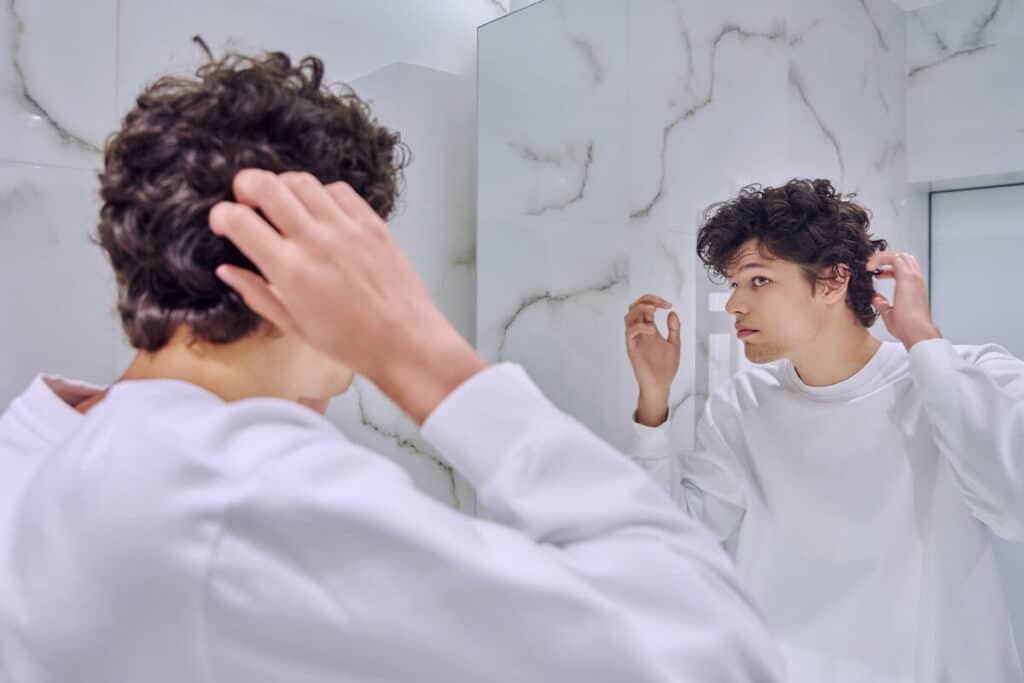“Looksmaxxing” is one of the latest social media trends followed by teenage boys. The term itself has been around for over a decade, but in recent years has evolved and gotten more popular, in part due to the rise of the trend on social media,.1 Looksmaxxing, as the name implies, means maximizing your physical appearance. Different forms exist, including “softmaxxing,” which might only involve adopting a new skincare routine, hair style, diet or fitness regimen. More extreme forms of looksmaxxing, referred to as “hardmaxxing,” might include steroids, implants, and plastic surgery.1–3 Other terms associated with the trend include mogging, a looksmaxxer term to describing looking more attractive than someone else, and mewing, which is a technique that involves resting the tongue on the roof of the mouth to help define jawline and improve facial structure.2
More and more teen boys are spending time on their skincare, hair, and fragrance routine. Their main concerns appear to stem around not being tall enough, not being muscular enough, and not having a clear enough complexion.4 As part of the looksmaxxing trend, boys are trying to reach a certain height and have a “chiseled-looking” jawline.1
The teen years are a vulnerable time as young boys and girls try to fit in and navigate their changing bodies. While some components of looksmaxxing might not be harmful, such as trialing a new skincare routine or hairstyle, other forms may be more damaging. Potential harms of looksmaxxing may include declines in mental health.
When teens become overly conscious, or hyperfixated, on their looks they can develop unhealthy body images with can contribute to poor mental health.4 Body dissatisfaction is associated with stress, low self-esteem and depression, anxiety , suicidal ideation, a eating disorders, and reduced quality of life in adolescents.4 US survey data suggests that approximately 30% of adolescent boys report trying to gain weight or bulk up, while nearly 22% of young men report engaging in behaviors to enhance muscles, such as eating differently to enhance muscle, supplement use, and steroid use.5 Some of these proposed health seeking behaviors, such as a strong focus on muscle building and exercise can mask symptoms of an eating disorder.5 An emphasis on appearance often overshadows other traits and achievements, making appearance the focus of self-worth. These practices may encourage young boys and men to evaluate themselves solely based on their weight or perceived attractiveness.
In an attempt to looksmax, boys may restrict their diet and possibly lose too much weight. Losing too much weight during the teen years can prevent growth and reduce testosterone levels. A certain amount of weight is needed to grow and to have enough testosterone to achieve their look. A certain amount of nutrition is needed to go through puberty. In fact, having a certain amount of body fat is necessary to achieve pubertal development.6
Should you be worried if your son is looksmaxxing?
Looksmaxxing becomes potentially harmful when it interferes with an individual’s day-to-day life or causes boys to take drastic, unhealthy, and unsustainable measures to achieve a certain look. Having conversations with teen boys about their body, their body image, and their desired appearance is important. Including in that conversation the importance of prioritizing nutrition and exercise habits that are sustainable and that support their individual needs is also needed.
Boys who are curious about how to eat to support their physical growth and appearance should talk to an RD to determine the best nutrition and exercise plan for their individual body. When it comes to looksmaxxing, we want to looksmax based upon how YOU look best, not somebody else. The team at Laura Cipullo Whole Nutrition + Yoga are experts in adolescent nutrition and can help teen boys with figuring out how to looksmax safely for their amazing, unique bodies.
References
- Richards R. 112: Masculinity and Image: The Looksmaxxing Hashtag That Boys Follow But Parents Don’t See.
- Lally M. Teen boys and the rise of “looksmaxxing.” The Times. October 26, 2024. Accessed February 24, 2025. https://www.thetimes.com/life-style/parenting/article/looksmaxxing-meaning-tiktok-trend-dark-side-3npqcdbw7
- Usborne S. From bone smashing to chin extensions: how “looksmaxxing” is reshaping young men’s faces. The Guardian. February 15, 2024. Accessed February 24, 2025. https://www.theguardian.com/lifeandstyle/2024/feb/15/from-bone-smashing-to-chin-extensions-how-looksmaxxing-is-reshaping-young-mens-faces
- Baker JH, Higgins Neyland MK, Thornton LM, et al. Body dissatisfaction in adolescent boys. Dev Psychol. 2019;55(7):1566-1578. doi:10.1037/dev0000724
- Nagata JM, Ganson KT, Murray SB. Eating disorders in adolescent boys and young men: an update. Curr Opin Pediatr. 2020;32(4):476-481. doi:10.1097/MOP.0000000000000911
- Oehme NHB, Roelants M, Bruserud IS, et al. Low BMI, but not high BMI, influences the timing of puberty in boys. Andrology. 2021;9(3):837-845. doi:10.1111/andr.12985








